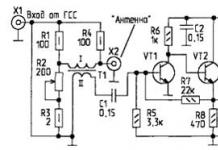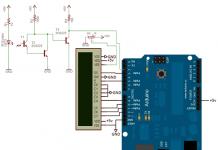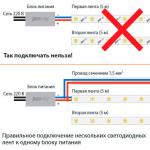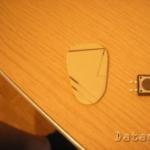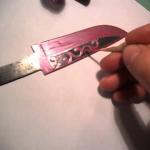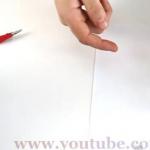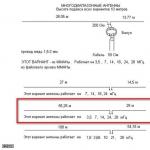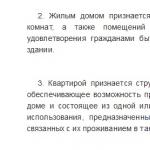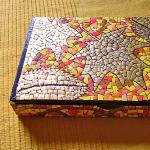A noise bridge, as its name suggests, is a bridge-type device. The noise source generates noise in the range from 1 to 30 MHz. With the use of high-frequency elements, this range is expanded, and if necessary, antennas in the 145 MHz range can be configured. The noise bridge works in conjunction with a radio receiver, which is used to detect the signal. Any transceiver will also work.
The schematic diagram of the device is shown in Fig. 1. The source of noise is the zener diode VD2. It should be noted here that some examples of zener diodes are not “noisy” enough, and the most suitable one should be selected. The noise signal generated by the zener diode is amplified by a broadband amplifier using transistors VT2, VT3.
The number of amplification stages can be reduced if the receiver used has sufficient sensitivity. Next, the signal is supplied to transformer T1. It is wound on a toroidal ferrite ring 600 NN with a diameter of 16...20 mm simultaneously with three twisted PELSHO wires with a diameter of 0.3...0.5 mm; number of turns -6.
The adjustable arm of the bridge consists of variable resistor R14 and capacitor C12. The measured arm is capacitors C10, SI and a connected antenna with an unknown impedance. A receiver is connected to the measuring diagonal as an indicator. When the bridge is unbalanced, a strong, uniform noise is heard in the receiver. As the bridge is adjusted, the noise becomes quieter and quieter. "Dead silence" indicates precise balancing. It should be noted that the measurement occurs at the receiver tuning frequency. The printed circuit board and the placement of parts on it are shown in Fig. 2.
The device is structurally made in a housing measuring 110x100x35 mm. On the front panel there are variable resistors R2 and R14, variable capacitors C11 and C12 and a supply voltage switch. On the side there are connectors for connecting a radio receiver and antenna. The device is powered by an internal Krona-type battery or accumulator. Current consumption - no more than 40 mA.
The variable resistor R14 and capacitor C12 must be equipped with scales.
Setting, balancing and calibration
We connect the radio receiver with the AGC system disabled to the corresponding connector. We install capacitor C12 in the middle position. By rotating resistor R2, you should make sure that the generated noise is present at the receiver input on all ranges. We connect non-inductive resistors of the MLT or OMLT type to the "Antenna" connector, having previously measured their values with a digital avometer. When connecting resistances, we achieve by rotating R14 a sharp decrease in the noise level in the receiver.
By selecting capacitor C12 we minimize the noise level and make marks on the R14 scale in accordance with the connected reference resistor. In this way, we calibrate the device up to the 330 Ohm mark.
Calibrating the C12 scale is somewhat more complicated. To do this, we alternately connect to the “Antenna” connector a parallel-connected 100 Ohm resistor and a capacitance (inductance) of 20...70 pF (0.2...1.2 µH). We achieve bridge balance by setting R14 at 100 Ohm on the scale and minimizing the noise level by rotating C 12 in both directions from the “O” position. If there is an RC chain, we put a “-” sign on the scale, and if there is an RL chain, we put a “+” sign. Instead of inductance, you can connect a 100...7000 pF capacitor, but in series with a 100 Ohm resistor.
Antenna impedance measurement
We set R14 to a position corresponding to the cable impedance - for most cases this is 50 or 75 Ohms. We install capacitor C12 in the middle position. The receiver is tuned to the expected resonant frequency of the antenna. We turn on the bridge and set a certain level of the noise signal. Using R14 we adjust to the minimum noise level, and using C12 we further reduce the noise. We carry out these operations several times, since the regulators influence each other. An antenna tuned to resonance must have zero reactance, and the active resistance must correspond to the characteristic impedance of the cable used. In real antennas, resistance, both active and reactive, can differ significantly from the calculated ones.
Determination of resonant frequency
The receiver is tuned to the expected resonant frequency. Variable resistor R14 is set to a resistance of 75 or 50 Ohms.
Capacitor C12 is set to the zero position, and the control receiver is adjusted in frequency until a minimum noise signal is obtained.
A simple method for matching HF antennas in “cold” mode.
Currently, antenna tuning and matching is carried out mainly using SWR meters, when a fairly large RF power is supplied to the antenna. At the same time, the antenna emits it, and since during tuning it is necessary to rebuild the transmitter several times within the operating range of the antenna, significant interference is created to other radio stations.
Meanwhile, there is another method of tuning antennas - using an HF bridge, it is described in the well-known Rothhammel reference book. But even in this case, the operation of the bridge requires significant power, which can provide sufficient current in the bridge arms.
However, if you slightly modernize the bridge, then you can use the signal of a conventional RF signal generator for tuning, with an output voltage of 0.5 - 1 volt. But for this it is necessary that the HF signal be modulated by a low-frequency signal of 400 -1000 Hz, and even better, that the generator operates in video modulation mode with pulses of this frequency.
Such modes are available in almost all modern signal generators.
The connection diagram for tuning the antenna to the desired frequency and matching it with a 50 ohm coaxial cable is shown in the figure. The RF generator is set to video modulation or AM mode with a modulation coefficient of 100% and connected to socket X1, the antenna - preferably first directly - is connected to socket X2. Headphones are connected to the HT sockets.
The generator is then tuned to the antenna frequency. If at the same time a low-frequency signal of the modulation frequency of the generator is heard in the headphones, it means that at this frequency the antenna has an input impedance different from the active 50 ohms. By adjusting the generator frequency in either direction from the set one, we achieve a loss of signal in the headphones. This will be the frequency at which the input resistance is active and equal to 50 ohms.
Depending on which direction and how different this frequency is from the desired one, we change the geometric dimensions of the antenna or the data of the matching elements, and again check the balance frequency of the bridge. Having achieved balance at the required frequency, we connect a 50 ohm feeder to the antenna, and perform a similar check of the entire antenna-feeder path.
If the feeder is in good working order and the settings are carried out correctly, after connecting the feeder there is no difference in measurements with or without a feeder, and connecting the SWR meter shows an SWR equal to 1, or close to it.
This method was tested when tuning antennas to a range of 14 MHz; both wire antennas were tuned for 160 and 80 meters, and a 4-element antenna for a range of 20 meters.
In all cases, it was possible to make adjustments quickly and accurately.
Standard signal generators (SSG) provide a voltage of 1...2 V at a 50 Ohm load, which is clearly not enough to work with bridge antenna resistance meters. In order to use conventional bridge resistance meters without modifying them, it is necessary to use a wideband power amplifier. The circuit of such an amplifier is shown in the figure.
The wideband amplifier provides at least 1 W of output power when operating in conjunction with the GSS in the frequency range from 1 to 30 MHz. If you reduce the supply voltage to 12 V and use the component ratings given in parentheses, the amplifier output power drops to 600 mW, which is sufficient to work with many types of measuring bridges. When assembling the amplifier from serviceable parts and setting the collector current indicated on the diagram, the amplifier is immediately operational and does not require adjustment. It is convenient to assemble the amplifier by hanging it.
Transformer T1 is made on a ring magnetic core with dimensions K7x4x2 made of ferrite with a permeability of 400...600. The windings contain 12 turns of wire of the PEL-2-0.35 type, wound with twist - one twist per centimeter. The ferrite ring can also be used in larger sizes. The amplifier can be assembled in a housing made of foil fiberglass. Transistor VT1 is installed on the radiator. High-frequency input-output jacks and amplifier power leads are output to the amplifier housing.
Sometimes it is inconvenient to use a GSS in conjunction with a power amplifier. This may be cases when measurements are carried out in the field; with a GSS powered by batteries, etc. In this case, you can use a bridge with a high-frequency unbalance voltage amplifier.
The diagram of such a bridge is as follows:

The difference between it and other bridge meter circuits is that the high-frequency voltage is not detected and measured immediately, but is supplied through transformer T1 to the input of a transistor two-stage amplifier and then detected. This makes it possible to dispense with the RF voltage levels produced by the standard signal generator when tuning antennas. The amplifier can be assembled using any high-frequency transistors such as KT315, KT312. The amplifier's frequency response is linear up to 40 MHz. Transformer T1 contains 22 turns of PEL-0.1 wire in each winding. The windings are located symmetrically on both halves of the ring with dimensions K10x7x4 with a permeability of 400...600
Calibration of the device consists of marking the load resistance on the dial of the variable resistor R2. This is best done using a digital ohmmeter. The dial readings when balancing the bridge will correspond to the resistance of the antenna being measured.
The bridge meter is assembled in a housing made of foil fiberglass. Its installation should be as compact and rigid as possible. The variable resistor limb should have the largest possible dimensions to increase measurement accuracy.
Figure 1 shows a circuit of an RF bridge developed based on the UA9AA design.

Fig.1
As a rule, the suspended installation used in the manufacture of a bridge limits the operating frequency range of such devices to 140...150 MHz. To ensure operation in the 430 MHz range, it is advisable to manufacture the device on a double-sided foil PCB. One of the successful installation options is shown in Fig. 2 and 3.

Fig.2
On the upper side of the board (Fig. 2) there are two non-inductive resistors R1, R2 with compensation capacitors C4, C5. The remaining parts of the bridge are located on the lower side (Fig. 3). The installation was carried out on the "spots".

Fig.3
The distances between the “patches” are determined by the sizes of the parts used. The circles, indicated in the figures by dashed lines, are connected to each other through holes in the board.
When making a bridge, special attention should be paid to the quality of the parts used. Capacitors C1, C2 - ceramic, leadless, type K10-42, K10-52 or similar. The reference capacitor C3 is KDO-2. Trimmer capacitors C4, C5-type KT4-21, KT4-25; the remaining capacitors are KM, KTs. Resistors R1, R2 must be of type MON, C2-10, C2-33 with a power of 0.5 W and have the same resistance within 20...150 Ohms. If MON type resistors are used, then their leads are bitten off to the base, which is cleaned and tinned, and then soldered to the desired “patch”. Resistor R3 - type SP4-1, SP2-36, non-induction, with graphite track. This resistor is mounted on the side wall made of foil PCB, but the foil at the place of its attachment is removed. The resistor body is not connected to the common wire, otherwise the bridge cannot be balanced. The handle attached to the resistor axis must be made of insulating material. In addition to resistor R3, CP-50 connectors are mounted on the side walls. The joints (joints) between the side walls and the main board are carefully soldered.
The signal power from the generator should be about 1 W. For example, IC-706MK2G, varactor tripler, etc. can be used as a generator.
When checking RF bridge balancing in the VHF and UHF bands, only non-inductive resistors are used. Precise tuning of compensation capacitors (with the same load resistance) corresponds to a constant balance on several ranges (for example, 7...430 MHz). If it is not possible to select a sufficient number of non-inductive resistors for calibrating the bridge, intermediate values of the device scale can be calibrated in the low frequency ranges using common resistors, for example, the MLT or MT type.
To measure the load reactivity, you will need to replace the capacitor C5 with a variable one (with an air dielectric and a maximum capacitance of about 20 pF), however, the upper frequency limit of measurements is limited to the range of 144 MHz, because it is not possible to fully compensate for the installation capacity.
If the device uses chokes with an inductance of 200 μH, the frequency range of the bridge will be 0.1...200 MHz.
The proposed design has very good repeatability, in contrast to devices made using wall-mounted installations.
Literature
- Yu.Selevko (UA9AA). Antenna tuning device. Radio Amateur, 1991, N5, P.32...34.
